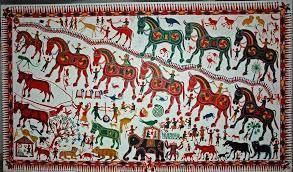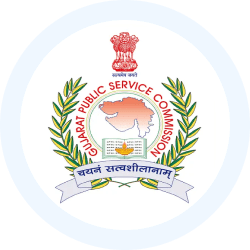GPSC (Gujarat) Exam > GPSC (Gujarat) Notes > Gujarat State PSC (GPSC) Preparation: All subjects > Paintings of Gujarat
Paintings of Gujarat | Gujarat State PSC (GPSC) Preparation: All subjects - GPSC (Gujarat) PDF Download
Introduction
- This style of miniature painting flourished in Gujarat from the 16th to the 19th century. It originated from Western Indian manuscript illustrations and later showed Mughal influence in its development.
- Gujarat miniature painting is distinct from Mughal painting in its use of bolder colors, a more abstract and conventional portrayal of human figures, and an ornamental approach to landscapes.
Paintings of Gujarat

Miniature Painting
- The Western Indian style of painting was prominent in regions like Gujarat, Rajasthan, and Malwa. Artistic endeavors in this area were greatly influenced by Jainism, much like how Buddhism inspired the arts of Ajanta and Pala.
- Jainism received royal patronage from the Kings of the Chalukya Dynasty who reigned over Gujarat, Rajasthan, and parts of Malwa from 961 A.D. until the late 13th century. They commissioned a large number of Jain religious manuscripts between the 12th and 16th centuries, seeking religious merit.
- Numerous Jain religious manuscripts from that period can be found in Jain libraries (bhandaras) scattered across Western India. These manuscripts showcase illustrations characterized by a vividly distorted style, featuring enlarged eyes, breasts, and hips, along with flat figures and angular features.
- From the 12th to the 16th centuries, manuscripts were typically crafted on palm leaves, transitioning to paper later on. Notable examples include the Kalpasutra manuscripts found in various locations such as the Devasano pado Bhandar in Ahmedabad and the Prince of Wales Museum in Bombay.
- In the 8th century, the tradition of miniature painting emerged in eastern India, spreading to the west and Gujarat by the 10th century. Initially serving ornamental purposes, these paintings eventually became visual aids for religious texts.
- Miniature paintings from Gujarat often depicted gods and goddesses inspired by stone carvings. The Lalbhai Dalpathbhai Institute of Indology in Ahmedabad houses a vast collection of handwritten Jain manuscripts and illustrated versions, showcasing the rich artistic heritage of the region.
Oil Paintings
- Oil paintings are made by mixing colors with drying oil, which acts as a binder. Different types of oils are chosen based on how quickly they dry or how they look. Each oil gives the paint different qualities, like a stronger yellow color or changes in how shiny the paint is.
- Artists who use oil paints might use two or more types of oil in one painting to create different shine and texture effects. Common oils used include walnut oil, safflower oil, poppy seed oil, and linseed oil.
- To make the paint shinier, the oil is mixed with pine resin or frankincense and then boiled. These resins are what give many oil paintings their glossy finish.
Glass Painting
- Glass painting is a traditional art style from Gujarat, dating back to the 18th century.
- It is believed that Chinese artists introduced glass painting to Gujarat.
- Initially, a design is etched on the back of the glass, followed by coloring from the same side.
- Today, glass painting has evolved to include various designs, themes, and colors.
- These paintings are known for their vibrant and rich color schemes.
Kalamkari art form
- The traditional art form known as Kalamkari in Gujarat has strong religious connections and is specifically referred to as Mata ni Pachedi.
- Artists create these intricate paintings on a light cream-colored fabric.
- The themes depicted in these artworks mainly revolve around religious figures such as gods and goddesses.
- These paintings are commonly used as backdrops for statues of Goddess Durga in various temples.
- Devotees often bring these paintings as offerings to the Goddess when their prayers are answered.
- During religious celebrations, these paintings are highly valued in both rural and urban parts of the state.
- Over time, there has been a shift from entirely hand-painted textiles to a combination of block-printed and hand-painted fabrics. In this newer method, printing blocks are used for creating borders while the remaining portions of the painting are done by hand.
Pethora
- Guided by rituals conducted by the Badvo officiating as the head priest for the associated rituals, the pithora or pithoro painting is carried out by the Lakahara group. This type of painting is done to celebrate a special event or to ask Pithora Baba for help with issues like sickness or lack of rain.
- The stories and events linked to this esteemed tribal chief are central to the pithoro. Ceremonies connected to this art form involve singing, dancing, drinking, and feasting.
- The procedure starts with treating walls using cow dung and white chalk powder, often brought by unmarried girls. Powders, earth, and vegetable colors are mixed with milk and mahuda flower liquor to create the dye for the pithoro in colors like yellow, indigo, orange, green, vermilion, red, and silver.
- Brushes are crafted from bamboo, neem, and other twigs that are frayed by chewing, beating, and other techniques. The painting commences after offerings are made to the lord.
- While the pithoro is being painted, the Badvo chants prayers and tales and enters a trance. Many pithoros depict the marriage of Pithora Baba and Pithori, with processions featuring lively dancing people and animals.
- Pithoros also portray various aspects of life among the Rathwas—musicians, dancers, protectors, feasting, men climbing palm trees, milking cows, livestock grazing, women churning butter, and bullock carts plowing fields.
- A distinctive feature of several pithoros is Raja Bhoj with an elephant procession. Animistic figures of bulls, horses, birds, and tigers are present in each pithoro. Near the tiger images, live sacrifices are offered.
Warli Painting
- Warli painting is a type of art created by craftspeople near Gujarat's border. It is a skill of indigenous individuals and is well-liked all over India.
- Colorful images best portray the philosophy of life, especially that of tribal communities. These simple tribal paintings spontaneously express folk creativity, beliefs, and traditions.
- The interesting themes in Warli Paintings are derived from the varied emotions and moments of tribal life, making them more than just wall designs; they are genuine reflections of a way of life.
- Originating from the walls of the Warli village, Warli, an Indian traditional art form, has transcended borders and is now treasured by numerous collectors and art enthusiasts.
Rogan Painting
- Rogan painting is a special art form practiced by a select few families.
- Rogan painting involves creating a thick mixture made by boiling safflower, caster, or linseed oil and adding it to water.
- This mixture is combined with chalk color pigment and a binding agent to make a dense dye.
- Artists use a stick, rod, or metal block to apply the paint onto cloth.
- Typical designs include geometric patterns and flowers.
- The colors commonly used are red, blue, and yellow.
- Rogan painting is utilized to adorn various items such as wall hangings, tablecloths, curtains, sarees, and skirt borders.
Question for Paintings of GujaratTry yourself: What type of oil is commonly used in oil paintings to create different shine and texture effects?View Solution
The document Paintings of Gujarat | Gujarat State PSC (GPSC) Preparation: All subjects - GPSC (Gujarat) is a part of the GPSC (Gujarat) Course Gujarat State PSC (GPSC) Preparation: All subjects.
All you need of GPSC (Gujarat) at this link: GPSC (Gujarat)
FAQs on Paintings of Gujarat - Gujarat State PSC (GPSC) Preparation: All subjects - GPSC (Gujarat)
| 1. What are some famous paintings of Gujarat? |  |
Ans. Some famous paintings of Gujarat include Pithora paintings, Warli paintings, and Madhubani paintings.
| 2. What is the significance of Pithora paintings in Gujarat? |  |
Ans. Pithora paintings are considered sacred by the Rathwa tribe of Gujarat and are used in rituals to seek blessings for prosperity and protection.
| 3. How are Warli paintings different from other art forms in Gujarat? |  |
Ans. Warli paintings are known for their simple geometric patterns and are traditionally created by the Warli tribe of Gujarat using a white pigment on a mud base.
| 4. What themes are commonly depicted in Madhubani paintings of Gujarat? |  |
Ans. Madhubani paintings often depict scenes from Hindu mythology, nature, and daily life, showcasing vibrant colors and intricate patterns.
| 5. How can one learn more about the traditional paintings of Gujarat? |  |
Ans. One can attend workshops, visit art galleries, or explore online resources to learn more about the traditional paintings of Gujarat and their cultural significance.
Related Searches




















